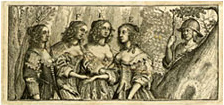John Barrow, Dictionarium polygraphicum (1735)
Full Text
Not available
EEBO/TCP
Not available
Date
1735
Lexicographer
Book title
Dictionarium Polygraphicum: Or, The Whole Body of Arts Regularly Digested. Containing, I. The Arts of Designing, Drawing, Painting, Washing Prints, Limning, Japanning, Gilding in all their various kinds. Also Perspective, the Laws of Shadows, Dialling, &c. II. Carving, Cutting in Wood, Stone; Moulding and Casting Figures in Plaister, Wax, Metal; also Engraving, and Etching, and Mezzotinto. III. A brief historical Account of the most considerable Painters, Sculptors, Statuaries, and Engravers, with those Cyphers or Marks by which their Works are known. IV. An Explanation of the Emblematical and Hieroglyphical Representations of the Heathen Deities, Powers, Human Passions, Virtues, Vices, &c. of great Use in History Painting. V. The Production, Nature, Refining, Compounding, Transmutation and Tinging all sorts of Metals and Minerals of various Colours. VI. The Arts of Making, Working, Painting or Staining all sorts of Glass and Marble; also Enamels, the imitation of all sorts of Precious Stones, Pearls, &c. according to the Practice both of the Antients and Moderns. VII. Dying all sorts of Materials, Linen, Woollen, Silk, Leather, Wood, Ivory, Horns, Bones; also Bleaching and Whitening Linen, Hair, &c. VIII. The Art of Tapestry-Weaving, as now performed in England, Flanders and France, either of the high or low Warp; also many other curious Manufactures. IX. A Description of Colours, Natural and Artificial, as to their Productions, Natures or Qualities, various Preparations, Compositions and Uses. X. The method of making all kinds of Inks, both Natural and Sympathetical; and also many other Curiosities not here to be specified, whereby this is rendred a more Compleat Work than has hitherto appear'd in any language.
Publication place
London
Publisher
C. Hitch, C. Davis, and S. Austen
Text type
printed book
Genre
Hard-word, term-of-art, and dialect dictionaries, glossaries, and definitions
Subject area
art
Language
headwords: English
explanations: English
explanations: English
explanations: English
explanations: English
Extent
2 vols.
Word-group
type: alphabetical
Word-entry
type: headword
sample: Grossness is represented in painting, by a gross corpulent woman, holding an olive branch in her right hand bearing fruit without leaves, in her left a crab. The olive branch denotes fatness; the crab as much subject to fatness, where the moon increases either from the particular quality of the moon, or else because when it is full moon; the crab has by the light a fairer opportunity to procure its food.
sample: Grossness is represented in painting, by a gross corpulent woman, holding an olive branch in her right hand bearing fruit without leaves, in her left a crab. The olive branch denotes fatness; the crab as much subject to fatness, where the moon increases either from the particular quality of the moon, or else because when it is full moon; the crab has by the light a fairer opportunity to procure its food.
STC
T031837
Catalog
Tonelli, Giorgio, Eugenio Canone, and Margherita Margherita . A Short-title List of Subject Dictionaries of the Sixteenth, Seventeenth and Eighteenth Centuries. Firenze: L. S. Olschki, 2006. no. 14 view record
Other editions
1758 (ESTC T145297; 2nd edn.)




